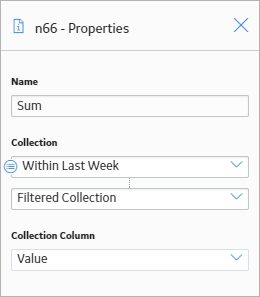The Properties window for a Sum node contains the items that are described in the following table.
|
Item |
Description |
Notes |
|---|---|---|
|
Collection section |
Specifies the collection that contains the values for which you want to calculate the total value. |
You can select Note: If the input specified for a Sum node is an empty collection, the resulting answer from the Sum node is automatically zero (0). |
|
Collection Column section |
Specifies the column that contains that values for which you want to calculate the total value. |
This list contains the columns that are available in the selected collection. The column that you select must contain numeric or time span values. |

